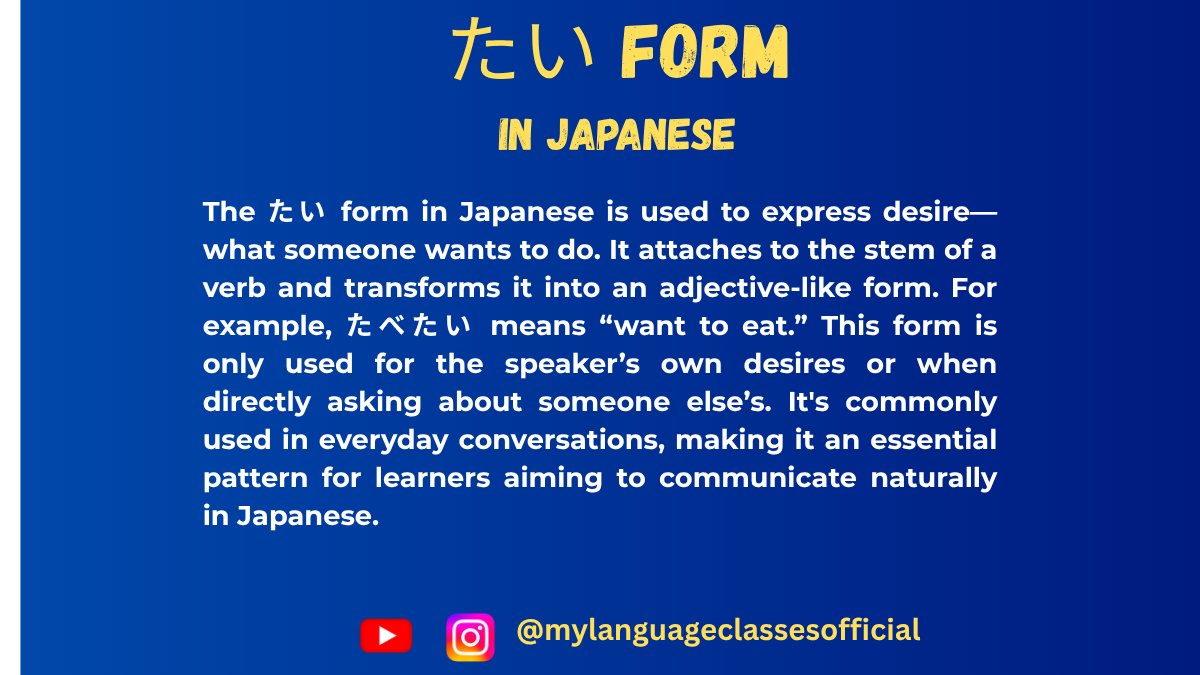Your cart is currently empty!
Tag: expressing desire
-

How to Use たい Form in Japanese | My Language Classes
Mastering the Japanese たい Form: A Comprehensive Guide
When learning Japanese, expressing what you want to do is an exciting milestone. The たい form is a versatile and commonly used grammar pattern that helps convey your desires and preferences. Whether you’re talking about your favorite foods, activities, or hobbies, mastering the たい form will greatly enhance your conversational skills. Let’s break it down step by step!
What Is the たい Form?
The たい form is used to express the desire to perform a certain action. In English, this is equivalent to saying, “I want to [do something].” It attaches to the stem of a verb, making it both straightforward and easy to use.
Building the たい Form for All Verb Groups
In Japanese, verbs are categorized into three groups: Group 1 (う-verbs), Group 2 (る-verbs), and Group 3 (Irregular verbs). Let’s dive into how to form the たい form for each group.
Group 1 (う-Verbs)
Group 1 verbs, also known as う-verbs, have dictionary forms that end with an う sound (e.g., 飲む, 読む, 書く).
Steps to form the たい form:
- Remove the final う sound from the verb.
- Replace it with い and add たい.
Examples:
- 飲む (nomu, “to drink”) → 飲みたい (nomitai, “want to drink”)
- 読む (yomu, “to read”) → 読みたい (yomitai, “want to read”)
- 書く (kaku, “to write”) → 書きたい (kakitai, “want to write”)
Negative form:
- Follow the same steps to form the たい structure.
- Replace たい with たくない.
Examples:
- 飲む → 飲みたくない (nomitakunai, “don’t want to drink”)
- 読む → 読みたくない (yomitakunai, “don’t want to read”)
- 書く → 書きたくない (kakitakunai, “don’t want to write”)
Group 2 (る-Verbs)
Group 2 verbs, also known as る-verbs, have dictionary forms that end with る preceded by an い or え sound (e.g., 食べる, 見る).
Steps to form the たい form:
- Drop the る from the verb.
- Add たい to the stem.
Examples:
- 食べる (taberu, “to eat”) → 食べたい (tabetai, “want to eat”)
- 見る (miru, “to see/watch”) → 見たい (mitai, “want to see/watch”)
- 開ける (akeru, “to open”) → 開けたい (aketai, “want to open”)
Negative form:
- Drop the る from the verb.
- Add たくない to the stem.
Examples:
- 食べる → 食べたくない (tabetakunai, “don’t want to eat”)
- 見る → 見たくない (mitakunai, “don’t want to see/watch”)
- 開ける → 開けたくない (aketakunai, “don’t want to open”)
Group 3 (Irregular Verbs)
Group 3, or irregular verbs, includes only two main verbs: する (“to do”) and 来る (“to come”).
Steps to form the たい form:
- する: Replace する with したい.
- 来る: Change to 来たい (きたい, kitai).
Examples:
- する (suru, “to do”) → したい (shitai, “want to do”)
- 来る (kuru, “to come”) → 来たい (kitai, “want to come”)
Negative form:
- する: Replace したい with したくない.
- 来る: Replace 来たい with 来たくない.
Examples:
- する → したくない (shitakunai, “don’t want to do”)
- 来る → 来たくない (kitakunai, “don’t want to come”)
Summary Chart
Verb Type Dictionary Form Stem Positive たい Form Negative たくない Form Group 1 (う) 飲む (nomu) 飲み 飲みたい (nomitai) 飲みたくない (nomitakunai) Group 2 (る) 食べる (taberu) 食べ 食べたい (tabetai) 食べたくない (tabetakunai) Group 3 (Irregular) する (suru) — したい (shitai) したくない (shitakunai) 来る (kuru) — 来たい (kitai) 来たくない (kitakunai) Practice It!
Try converting the following verbs into their たい and たくない forms:
- 書く (kaku, “to write”)
- 遊ぶ (asobu, “to play”)
- 勉強する (benkyou suru, “to study”)
- 起きる (okiru, “to wake up”)
Let us know how you did in the comments!
Polite Forms
The examples above are in casual form, which is great for conversations with friends or family. To make it polite, simply conjugate the たい form with です:
- 食べたい → 食べたいです (tabetai desu, “want to eat”).
- 食べたくない → 食べたくないです (tabetakunai desu, “don’t want to eat”).
Examples:
- 映画を見たいです。
Eiga o mitai desu.
“I want to watch a movie.” - 海に行きたくないです。
Umi ni ikitakunai desu.
“I don’t want to go to the beach.”
Notes on Usage
- First-Person Focus:
The たい form is primarily used to express the speaker’s desires. For example:- 私はケーキを食べたいです。
Watashi wa keeki o tabetai desu.
“I want to eat cake.”
- 私はケーキを食べたいです。
- Context Matters:
Use たい sparingly in formal writing or professional settings. Instead, opt for more polite expressions such as ~たいと思っています (~tai to omotteimasu, “I am thinking I want to…”). - Flexibility in Sentences:
The たい form is flexible and integrates seamlessly into various sentence structures:- 何を食べたいですか?
Nani o tabetai desu ka?
“What do you want to eat?” - 明日は公園に行きたいです。
Ashita wa kouen ni ikitai desu.
“I want to go to the park tomorrow.”
- 何を食べたいですか?
Practice Makes Perfect
Try creating your own sentences with the たい form! Here are some practice prompts:
- What do you want to do this weekend?
- Name three things you don’t want to do.
- Use the たい form in a polite question.
Final Thoughts
The たい form is a valuable tool for expressing your wants and preferences in Japanese. Whether you’re planning your next meal or your next adventure, it helps bring personality and clarity to your conversations. Practice it often, and you’ll find yourself communicating your desires naturally in no time. 頑張って!(Ganbatte! – Good luck!)
What do you want to express in Japanese today? Share in the comments below! 😊
If you enjoyed this lesson, be sure to check out more posts like this on my blog at My Language Classes. Don’t forget to subscribe my YouTube channel and follow me on Instagram for the latest language learning tips and lessons. Leave a comment below to share your thoughts, or ask any questions you have about nouns.
Happy learning! 😊
